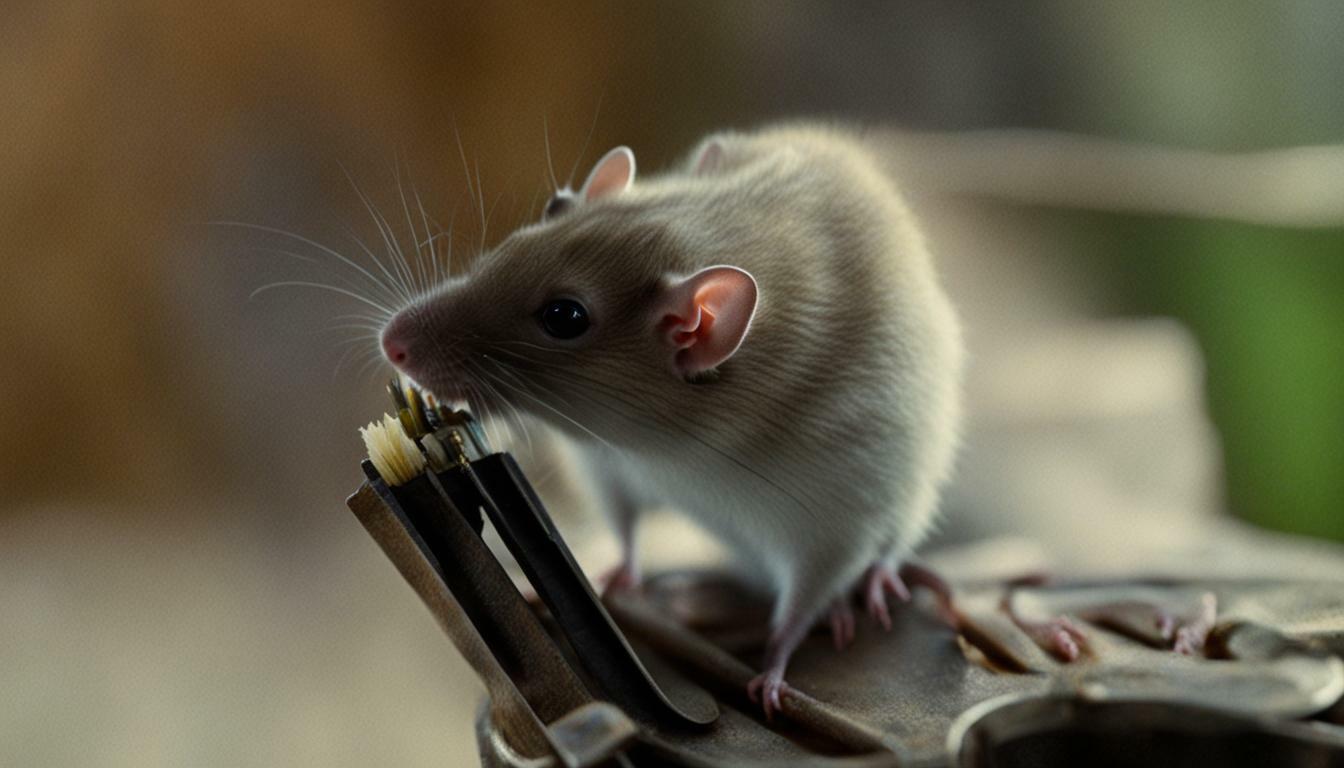If you’ve ever wondered if rats have the ability to trim their own nails, you’re not alone. Many rat owners are curious about whether their furry companions can take care of this grooming task on their own. In this article, we’ll explore the fascinating world of rat grooming habits and find out if rats truly have the ability to trim their own nails.
Key Takeaways:
- Rats are generally capable of trimming their own nails through natural activities like running and climbing.
- They may also use their teeth to clip off the ends of their nails when necessary.
- Some owners choose to trim their rats’ nails, especially if the rats have certain limitations or conditions.
- When trimming rat nails, it is important to be cautious and avoid cutting into the quick.
- Passive methods, like providing rough surfaces in the cage, can also help wear down rats’ nails naturally.
Understanding Rat Grooming Behaviors
Rats are meticulous groomers and devote a significant amount of time to self-care. Their grooming behaviors play a crucial role in maintaining their overall hygiene and health, including the maintenance of their nails. A rat’s grooming routine involves various activities, such as licking, scratching, and nibbling, all aimed at keeping their fur clean and free of parasites.
During their grooming sessions, rats also pay attention to their nails. They will nibble on their nails to keep them at a manageable length. This self-grooming behavior not only helps prevent their nails from becoming overly long but also aids in removing any dirt or debris that may have accumulated. Rats have sharp incisors that are capable of effectively clipping off the ends of their nails when necessary.
While rats are generally able to maintain their own nails, there are instances where additional nail care may be required. Older rats or those with hind leg degeneration may struggle to reach their back feet for nail trimming. In such cases, some owners choose to assist their rats in nail maintenance by carefully trimming their nails. It is important to exercise caution when doing so to avoid cutting into the quick, which can cause bleeding and discomfort for the rat.
When trimming a rat’s nails, it is recommended to have someone else hold the rat securely, ensuring their safety and minimizing stress. Small human nail clippers or small animal nail clippers can be used for this purpose. It is important to use appropriate tools that are sharp and clean to avoid any potential infections or injuries. Alternatively, passive methods can be employed to help wear down the rats’ nails naturally. Placing rough surfaces like bricks or lava ledges in their cage allows the rats to naturally file their nails as they move about.
| Key Points: |
|---|
| Rats are meticulous groomers and devote a significant amount of time to self-care. |
| They engage in various grooming behaviors to keep their fur clean and nails maintained. |
| Rats can trim their own nails by nibbling on them, preventing them from becoming overly long. |
| For older rats or those with hind leg degeneration, nail trimming may be necessary to maintain proper nail length. |
| When trimming nails, precautions should be taken to avoid cutting into the quick. |
| Using small human or animal nail clippers and having someone hold the rat securely is recommended for safe trimming. |
| Passive methods, such as providing rough surfaces in their cage, can also help maintain the rats’ nail length. |
Natural Nail Maintenance in Rats
Rats have a natural way of keeping their nails at an appropriate length. They have an instinctual tendency to engage in activities that naturally wear down their nails, such as running and climbing. These activities allow rats to exert pressure on their nails, which gradually helps to file them down. So, you may be relieved to know that in most cases, you don’t need to worry about trimming your rat’s nails.
However, there are instances where nail trimming may be necessary, especially for older rats or those with hind leg degeneration who may struggle to maintain their nail length. In such cases, it is important to approach nail trimming with caution to avoid causing any harm to your furry friend.
When it comes to trimming a rat’s nails, it is recommended to have someone assist you in holding the rat gently but securely. You can use small human nail clippers or small animal nail clippers, ensuring that they are sharp and clean. Take care not to cut into the quick, which is the small vein inside the nail, as this can cause bleeding and discomfort for your rat.
Alternatively, if you prefer a more passive approach to nail maintenance, you can incorporate rough surfaces like bricks or lava ledges into your rat’s cage. These surfaces naturally help to wear down the nails as your rat moves around and explores.
| Benefits of Natural Nail Maintenance | Tips for Nail Trimming |
|---|---|
|
|
The Role of Running and Climbing
The constant running and climbing that rats engage in play a crucial role in keeping their nails trimmed. Rats are naturally active animals, and their daily activities provide opportunities for their nails to be worn down. As they scurry around their environment, their nails come into contact with various surfaces, such as cage bars or branches, which helps to file them down.
Rats are also skilled climbers, using their sharp claws to grip onto different surfaces as they navigate their surroundings. This climbing behavior further contributes to the natural maintenance of their nails. When rats climb, they use their nails to grip onto the surface, causing slight abrasion that gradually wears down the nail length over time.
In addition to running and climbing, rats possess the ability to self-groom. They use their teeth to nibble and chew on their nails, particularly when the nails become too long. This self-trimming behavior allows rats to keep their nails at a comfortable and manageable length for their activities.
It is important to note that while running, climbing, and self-grooming are effective methods for maintaining nail length in rats, some owners may still prefer to trim their rats’ nails. This could be due to individual circumstances, such as older rats with reduced mobility or hind leg degeneration. In such cases, it is essential to exercise caution and use appropriate tools, such as small human or small animal nail clippers, to avoid cutting into the quick and causing discomfort to the rat.
| Key Points | Methods for Nail Maintenance |
|---|---|
| Rats engage in constant running and climbing | Their nails come into contact with various surfaces, helping to file them down |
| Rats use their claws to grip onto surfaces while climbing | This climbing behavior contributes to the natural maintenance of their nails |
| Rats self-groom by nibbling and chewing on their nails | This self-trimming behavior keeps their nails at a comfortable length |
| Some owners may choose to trim their rats’ nails | Caution must be exercised to avoid cutting into the quick |
Teeth Clipping as a Nail Trimming Mechanism
When rats find that their nails have grown too long, they have a unique way of addressing the issue. These intelligent rodents will use their teeth as a natural nail trimming tool. Just like how they gnaw on objects to maintain healthy teeth, rats will also nibble on their nails to keep them short and manageable.
This teeth clipping behavior is not only limited to their front paws but also extends to their hind paws. Rats are flexible creatures, able to contort their bodies to reach their back feet when necessary. They use their sharp incisors to neatly trim off the excess length, maintaining their nails at a comfortable level.
However, it’s important to note that teeth clipping is not the primary method rats use for nail maintenance. They rely more heavily on their natural activities, such as running and climbing, to naturally wear down their nails. This is why providing them with ample opportunities for physical exercise is crucial for their overall well-being and nail care.
If you’re concerned about your rat’s nails and prefer to take a more hands-on approach, you can choose to trim them yourself. It’s essential to exercise caution and use the right tools. Small human nail clippers or specialized small animal nail clippers are recommended. When trimming, be mindful of the quick, a small vein in their nails, to avoid causing any injury. It’s always helpful to have an extra pair of hands to hold the rat securely while you trim.
| Quick Tips for Safe Rat Nail Trimming |
|---|
| 1. Use small human nail clippers or small animal nail clippers specifically designed for small rodents. |
| 2. Be cautious and avoid cutting into the quick, which can cause bleeding and discomfort. |
| 3. Have someone assist you in holding the rat securely during the nail trimming process. |
| 4. Trim only a small amount of nail at a time to reduce the risk of accidents. |
| 5. Monitor your rat’s nails regularly and trim as needed, especially if they have difficulty maintaining them naturally. |
Alternatively, you can opt for passive methods to help wear down your rat’s nails naturally. Placing rough surfaces like bricks or lava ledges in their cage provides an opportunity for them to naturally file their nails as they move and explore their environment. These surfaces act as miniature nail files, gradually reducing nail length over time.
In conclusion, while rats are capable of trimming their own nails using their teeth, they primarily rely on their natural activities to maintain nail length. Whether or not to trim your rat’s nails is a personal choice, but it’s important to consider their overall health and well-being. Regular observations, safe nail trimming practices, and providing appropriate environmental enrichment can all contribute to healthy nail maintenance for these intelligent and curious creatures.
Rat Nail Trimming for Special Cases
While most rats are capable of managing their own nail length, there are certain circumstances where nail trimming becomes important. These special cases include situations where the rats are older and may have difficulty reaching their back feet or have hind leg degeneration. In these instances, owners may choose to trim their rats’ nails to prevent discomfort or potential injuries.
When it comes to DIY rat nail trimming, it is crucial to approach the task with caution and care. Cutting into the quick, which is the small vein in their nails, can cause bleeding and pain for your furry friend. To ensure a safe trimming experience, it is recommended to have someone help hold the rat while you perform the nail clipping.
For the actual trimming, it is best to use small human nail clippers or small animal nail clippers. These tools provide greater precision and control compared to larger clippers. Take your time and trim the nails in small increments, avoiding the quick. If you are unsure about how much to trim, consult a veterinarian or a professional who is experienced with small animals.
Alternatively, there are passive methods available to help wear down rats’ nails naturally. Placing rough surfaces like bricks or lava ledges in their cage can help to file down the nails as they run and climb. This can be a less stressful option for both you and your rat if you are uncomfortable with the idea of nail trimming.
| Pros of DIY Rat Nail Trimming | Cons of DIY Rat Nail Trimming |
|---|---|
|
|
Ultimately, the decision of whether or not to trim your rat’s nails is a matter of personal preference as well as the specific needs of your pet. Regardless of your choice, always prioritize their well-being and ensure their nails are maintained at a comfortable length to promote their overall health and happiness.
Tips for Safe Rat Nail Trimming
If you decide to trim your rat’s nails, it’s essential to follow some guidelines to ensure their safety and well-being. Rats have delicate nails, and cutting into the quick can cause pain and bleeding. Here are some tips to help you trim your rat’s nails effectively:
- Have someone assist you: Trimming a rat’s nails can be challenging, especially if they are squirming or anxious. Enlist the help of a second person to hold the rat gently but securely while you trim their nails.
- Use the right tools: Avoid using regular scissors or clippers meant for humans, as they may be too large and could cause accidental injury. Instead, opt for small human nail clippers or small animal nail clippers specifically designed for small pets like rats.
- Be cautious with the length: When trimming your rat’s nails, it’s important to avoid cutting too close to the quick, which is the small vein inside the nail. Trim small increments at a time and observe the nail carefully to ensure you don’t cut into the quick.
- Provide treats and positive reinforcement: Make the nail trimming experience more pleasant for your rat by offering them treats before, during, and after the process. This will help create a positive association and make future trimming sessions easier.
Remember, not all rats require nail trimming as they are capable of maintaining their own nail length through their activities. If your rat’s nails are not excessively long and their mobility is not compromised, it may be best to let them naturally wear down their nails. However, if you do choose to trim their nails, make sure to take your time, be patient, and prioritize their safety above all else.
Table: Rat Nail Trimming Checklist
| Steps | Description |
|---|---|
| 1 | Gather necessary tools: small human nail clippers or small animal nail clippers, treats, and a second person to assist. |
| 2 | Securely hold your rat while offering treats for comfort. |
| 3 | Trim small increments of the nail, avoiding the quick. |
| 4 | Offer treats for positive reinforcement during and after the process. |
Tools and Techniques for Rat Nail Trimming
Choosing the right tools and techniques can make the nail trimming process smoother for both you and your rat. When it comes to selecting the tools, small animal nail clippers or small human nail clippers are recommended. These clippers are designed to be safe and easy to use on small animal nails, reducing the risk of accidental injury.
Before starting the nail trimming procedure, it’s essential to gather all the necessary supplies. Along with the nail clippers, have some styptic powder or cornstarch on hand to stop any bleeding in case you accidentally cut into the quick. This can happen despite being careful, so it’s always better to be prepared.
Now, let’s discuss the techniques for trimming your rat’s nails. It is recommended to have someone assist you by holding the rat gently and securely while you focus on the trimming process. Begin by gently extending the rat’s paw to expose the nails. Take care to identify the quick, which appears as a pinkish or red line within the nail. It’s crucial not to cut into the quick as it can cause bleeding and discomfort.
Hold the nail clippers perpendicular to the nail, avoiding a slanted angle. Make small, precise cuts at a time, trimming the nail gradually rather than all at once. This approach ensures that you do not accidentally nick the quick. Remember to focus on the curved part of the nail, avoiding the straight portion that contains the quick.
Avoid rushing the process and take breaks if needed, especially if your rat becomes stressed or anxious. Be patient and reward your rat with treats or praise after a successful nail trimming session. With proper tools and techniques, you can maintain your rat’s nail health and overall well-being.
Passive Methods for Nail Maintenance
If you prefer not to trim your rat’s nails, there are alternative methods to maintain their nail length. Rats have natural behaviors that can help wear down their nails over time, reducing the need for regular trimming. Here are some passive methods you can consider:
- Provide rough surfaces: Placing rough surfaces like bricks or lava ledges in your rat’s cage can help naturally file down their nails. As they run, climb, and explore their environment, their nails will come into contact with these abrasive surfaces, gradually wearing them down.
- Use lava ledges: Lava ledges are specifically designed to promote nail maintenance in small animals like rats. These textured platforms can be attached to the walls of their cage, allowing your rat to naturally wear down their nails as they move about and climb on the ledges.
- Offer chew toys: Rats have a strong instinct to chew, and providing them with suitable chew toys can also indirectly help with nail maintenance. Gnawing on appropriate toys can help naturally wear down their nails as they exercise their teeth.
It’s important to note that while these passive methods can be effective for many rats, they may not completely eliminate the need for occasional nail trimming, especially for rats with specific conditions or limitations. Regularly monitoring your rat’s nail length and overall health is still crucial to ensure they remain comfortable and free from any nail-related issues.
In summary, if you prefer not to trim your rat’s nails, there are passive methods you can employ to help maintain their nail length. Providing rough surfaces, such as bricks or lava ledges, and offering suitable chew toys can help wear down their nails naturally. However, it’s essential to regularly monitor your rat’s nails and seek professional advice if necessary. Remember, the well-being of your furry friend is always a top priority.
| Passive Methods for Nail Maintenance |
|---|
| Provide rough surfaces |
| Use lava ledges |
| Offer chew toys |
Conclusion
In conclusion, rats are generally capable of trimming their own nails through their natural grooming behaviors, but there may be certain circumstances where nail trimming becomes necessary.
While it is possible to trim rats’ nails, it is generally not necessary as they are able to take care of their own nails. Rats will naturally wear down their nails by running and climbing, and they will also clip off the ends with their teeth if needed.
However, some owners prefer to trim their rats’ nails, especially if they are older and unable to reach their back feet or have hind leg degeneration. When trimming their nails, it is important to be careful and avoid cutting into the quick, which is the small vein in their nails.
It is recommended to have someone help hold the rat and to use small human nail clippers or small animal nail clippers. Alternatively, there are passive methods to help wear down rats’ nails, such as placing rough surfaces like bricks or lava ledges in their cage.
Overall, whether or not to trim rats’ nails is a matter of personal preference for the owner.
FAQ
Do rats trim their own nails?
While it is possible to trim rats’ nails, it is generally not necessary as they are able to take care of their own nails. Rats will naturally wear down their nails by running and climbing, and they will also clip off the ends with their teeth if needed.
Why would I need to trim my rat’s nails?
Some owners prefer to trim their rats’ nails, especially if they are older and unable to reach their back feet or have hind leg degeneration.
How can I trim my rat’s nails safely?
When trimming their nails, it is important to be careful and avoid cutting into the quick, which is the small vein in their nails. It is recommended to have someone help hold the rat and to use small human nail clippers or small animal nail clippers.
Are there alternative methods for maintaining my rat’s nail length?
Yes, there are passive methods to help wear down rats’ nails, such as placing rough surfaces like bricks or lava ledges in their cage.
Is it necessary to trim my rat’s nails?
Whether or not to trim rats’ nails is a matter of personal preference for the owner.




